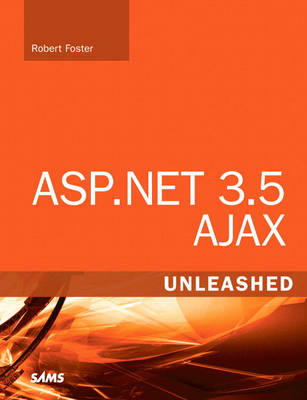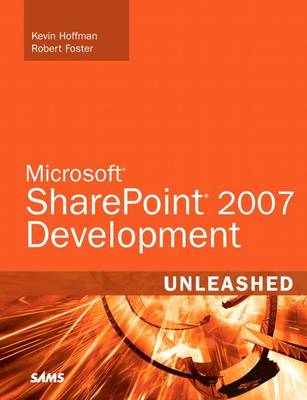Unleashed
2 total works
As the Internet user experience (UX) progresses, more users are demanding and expecting their custom-built business applications to provide the same UX that they see on the Internet every day. ASP.NET 3.5 AJAX Unleashed empowers ASP.NET developers to easily provide this type of experience with minimal code. Author Rob Foster has built AJAX-enabled web applications for a number of major corporations and uses the experience he has gained there to explain concisely, clearly, and completely what ASP.NET developers need to learn to start taking advantage of the rich opportunities made possible by ASP.NET AJAX.
- Learn ASP.NET AJAX by working with real-world examples
- Use the ScriptManager and ScriptManagerProxy controls in your ASP.NET AJAX-enabled applications
- Leverage the ASP.NET AJAX client-side API to maximize the flexibility of ASP.NET AJAX
- Build applications that use the UpdatePanel and Timer controls
- Use the ASP.NET AJAX Control Toolkit to provide rich AJAX functionality to your web applications
- Build ASP.NET AJAX-enabled extender controls
- Integrate ASP.NET AJAX and .NET 3.5 with Microsoft Office SharePoint Server 2007
- Create ASP.NET AJAX-enabled Windows Vista Gadgets
- Learn advanced AJAX concepts such as JavaScript Object Notation (JSON) and WCF Web services
Introduction 1
Part I Introduction
Chapter 1 Introduction to AJAX Technologies 5
AJAX and Web 2.0 6
Why Use AJAX? 7
AJAX Rationale 7
AJAX: An Example 8
The XMLHttpRequest Object 8
A Simple AJAX Library 10
Using the AJAX Library 14
Summary 20
Chapter 2 Introduction to ASP.NET AJAX 21
Introducing the Visual Studio Controls 22
ScriptManager 22
ScriptManagerProxy 23
Timer 23
UpdatePanel 23
UpdateProgress 23
Introducing the Visual Studio Projects and Web Site Items 24
Projects 24
Web Site Items 25
Introducing the AJAX Control Toolkit 26
Summary 27
Part II Working with ASP.NET 3.5 AJAX
Chapter 3 The ScriptManager and ScriptManagerProxy Controls 31
About the ScriptManager Control. 31
ScriptManager Properties, Methods, and Events 34
JavaScript Proxy Classes for Web Services 37
Partial-Page Rendering 43
Summary 47
Chapter 4 The ASP.NET AJAX Client API 49
The Namespaces 49
Global 49
Sys 52
Sys.Net 53
Sys.Serialization 54
Sys.Services 62
Sys.UI 66
Sys.WebForms 68
Summary 71
Chapter 5 The UpdatePanel and Timer Controls 73
About the UpdatePanel Control 73
Using the UpdatePanel Control 74
Advanced Features of the UpdatePanel Control 78
Triggers 78
Multiple UpdatePanel Controls on a Single Page 81
The Timer Control 89
Using the Timer Control with Partial-Page Rendering 90
Summary 92
Chapter 6 Advanced Techniques with the ASP.NET AJAX PageRequestManager Object 93
Using the PageRequestManager Object 93
A Practical Example of the PageRequestManager Object 95
Summary 100
Chapter 7 Using the ASP.NET AJAX Control Toolkit 101
ASP.NET AJAX Control Toolkit: The Controls 102
Using Controls in the ASP.NET AJAX Control Toolkit 105
Configuring Visual Studio to Use the Toolkit 105
The Accordion and AccordionPane Controls 106
The CalendarExtender Control 110
The CollapsiblePanelExtender Control 112
The ConfirmButtonExtender Control 118
The DragPanelExtender Control 120
The DropDownExtender Control 122
The FilteredTextBoxExtender Control 125
The HoverMenuExtender Control 127
The TextBoxWatermarkExtender Control 130
ASP.NET AJAX Control Toolkit: A Practical Example 134
Using the ASP.NET AJAX Control Toolkit with Microsoft Expression Web 145
Configuring Expression Web for the ASP.NET AJAX
Control Toolkit 145
Summary 150
Chapter 8 Building an ASP.NET AJAX Extender Control 151
Add ASP.NET Controls 151
How to Build an Extender Control 154
Server-Side Code 156
Client-Side Code 159
Summary 163
Chapter 9 ASP.NET AJAX and SharePoint 2007 165
SharePoint and AJAX 165
Modifying Web.Config 166
Developing an AJAX-Based SharePoint Web Part 171
Summary 177
Chapter 10 Creating ASP.NET AJAX-Enabled Vista Sidebar Gadgets 179
Vista Sidebar Gadgets 179
Creating the Gadget 181
Create the Web Service 181
Generate the JavaScript Proxy 183
Create the Vista Gadget 186
Test the Gadget 187
Summary 188
Part III Appendices
Appendix A Microsoft Expression Web 191
An Introduction to the Expression Web Interface 191
Creating Web Pages and Web Sites 191
Customizable Interface 194
Creating Standards-Based Web Sites 198
Quickly Build Standards-Based Sites 198
Code Formatting and IntelliSense 202
Autoformatting Code 202
IntelliSense 204
XML and XSLT Tools in Expression Web 204
Drag and Drop XML 205
Creating and Updating XSL 207
Summary 209
Appendix B Deploying the .NET Framework 3.5 as a SharePoint Feature 211
Features and Solutions 211
Creating the Solution 213
Using Visual Studio 214
Creating the Feature Receiver 218
Deploying the Solution to SharePoint 228
Compiling the Solution 228
Running STSADM.EXE to Register the Solution 234
Deploying the Solution Using SharePoint
Central Management 235
Activating the Feature 237
Summary 239
Index 241
Microsoft Sharepoint 2007 Development Unleashed
by Kevin Scott Hoffman and Robert Foster
This is the most comprehensive, practical guide to building enterpriseclass applications with SharePoint 2007, ASP.NET 2.0, Visual C# 2005, and the Microsoft Office 2007 system. Microsoft SharePoint 2007 Development Unleashed is designed for every working .NET developer: both those with SharePoint experience and those new to SharePoint. The authors thoroughly introduce SharePoint 2007 as a development platform and offer in-depth, example-rich coverage of every significant tool for programmers--from "Features and Solutions" to list events, from user profiles to Web Parts. You'll walk step-by-step through building each major type of SharePoint application. You'll also find in-depth coverage of SharePoint 2007's rich collection of built-in Web services, including services for building document workspaces, centralizing the management of Excel spreadsheets, ensuring security, and much more.
Detailed information on how to...
Use CAML, SharePoint's XML-based language for defining content, manipulating searches, and moreWork with the SharePoint Object ModelBuild reusable packages for easy deployment to SharePoint server farmsProgram SharePoint webs, sites, document libraries, and filesLeverage SharePoint 2007's improved lists and new list eventsManipulate and query meetings and Meeting WorkspacesIntegrate external business data into SharePoint applicationsConstruct business workflows for enterprise content management and other applicationsProgram ASP.NET-based SharePoint Web Parts, from the basics to state-of-the-art techniquesCreate Web Parts that can provide and consume data through connectionsUse SharePoint 2007's built-in Web services for managing document and Meeting Workspaces, imaging, and listsCentralize spreadsheet storage and management with Excel ServicesManage user profiles and enhance application securityDebug and deploy SharePoint 2007 applicationsWork with Records Repositories and metadata
Introduction 1
1 Collaborative Application Markup Language (CAML) Primer 5
Part I Programming with the SharePoint Object Model
2 Introduction to the SharePoint Object Model 15
3 Programming with Features and Solutions 25
4 Working with Sites and Webs 35
5 Managing SharePoint Lists 47
6 Advanced List Management 59
7 Handling List Events 69
8 Working with Document Libraries and Files 83
9 Working with Meetings 97
Part II Enterprise Content Management
10 Integrating Business Data 109
11 Creating Business Data Applications 121
12 Working with User Profiles 135
13 Building Workflows 147
Part III Programming SharePoint Web Parts
14 ASP.NET Server Control Primer 163
15 Introduction to Web Parts 173
16 Developing Full-Featured Web Parts 191
17 Building Web Parts for Maintaining SharePoint 2007 Lists 205
18 Building Connected Web Parts 217
19 Debugging and Deploying Web Parts 229
Part IV Programming the SharePoint 2007 Web Services
20 Using the Document Workspace Web Service 241
21 Using the Imaging Web Service 255
22 Using the Lists Web Service 273
23 Using the Meeting Workspace Web Service 291
24 Working with User Profiles and Security 307
25 Using Excel Services 321
26 Working with the Web Part Pages Web Service 337
27 Using the Business Data Catalog Web Services 347
28 Using the Workflow Web Service 359
29 Working with Records Repositories 369
30 Additional Web Services 377
Index 387

